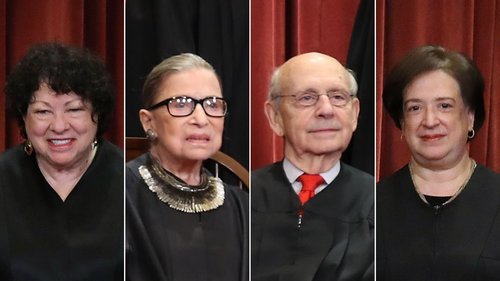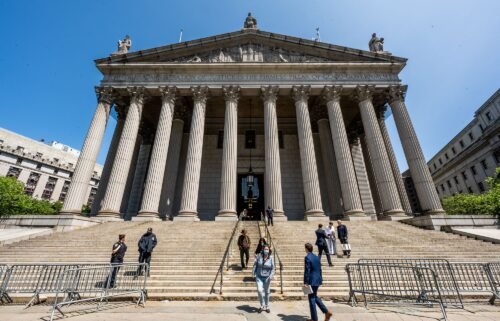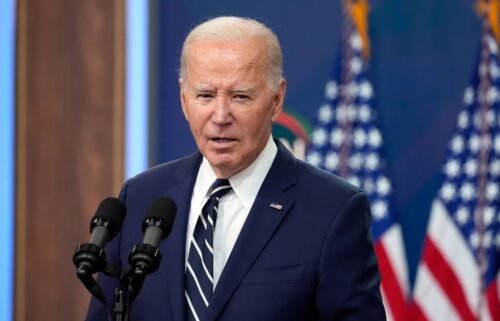Supreme Court’s liberals prepare for a spring of dissent

The four liberal justices of the Supreme Court are steeling themselves for a momentous spring as the reality settles in that the left flank of the bench could remain at least one critical vote shy of a majority in ideologically driven cases for decades.
Facing an emboldened conservative majority and a docket marked by some of the most consequential cases in recent years, the liberals, led by the ailing 86-year-old Ruth Bader Ginsburg, will work to stall the conservative legal revolution launched with the election of President Donald Trump who is fulfilling his pledge to transform the courts.
It won’t be easy.
On top of that, if Trump succeeds in November, there is a strong possibility that he would have another seat to fill particularly given Ginsburg’s age and that of Justice Stephen Breyer, who is 81. Trump would likely choose a young nominee along the lines of his first two Supreme Court picks Neil Gorsuch and Brett Kavanaugh.
Last month, the court dropped a bombshell: the justices agreed to review Trump’s bid to shield his financial documents from disclosure. That’s on top of a docket this term of explosive issues concerning immigration, abortion, LGBTQ rights and the 2nd Amendment. In addition, the justices may be faced with the option to — yet again — consider the fate of the Obama-era Affordable Care Act.
After swing vote Justice Anthony Kennedy retired in 2018, Ginsburg pointedly remarked that his departure would have far reaching consequences impacting not only current disputes, but those “many terms ahead.” As she battles her fourth bout of cancer, she remains on the bench often piping up early during oral arguments, subtly jousting with her conservative colleagues.
When the court is not in session she attends speaking events . Last month she told an audience in Washington that serving on the high court is the “best job I’ve ever had” and reiterated that she will stay on “as long as I will be able to do it full steam.” Asked about the current state of affairs in the US and abroad, Ginsburg said the country would emerge from anxious “bumpy periods.”
“We have in the past and we will again,” she said.
And after a term of transition last year, the four conservatives to the right of Chief Justice John Roberts have hinted more than once that they are ready to make their mark.
For instance, last spring, conservative Justice Clarence Thomas warned in an opinion related to an Alabama abortion access law, that the time was coming for the Supreme Court to revisit its abortion jurisprudence which he said had “spiraled out of control.”
“We cannot continue blinking the reality is what the Court has wrought,” Thomas wrote.
“The liberal justices know better than anyone else to what extent most if not all the Court’s conservative justices are bent on refashioning constitutional law,” said Michael Gerhardt of the University of North Carolina School of Law in Chapel Hill. “Trying to narrow the scope of decisions, as they have done in recent years, may remain their best strategy for minimizing what they would regard as the damage to existing constitutional law.”
Liberal Justice Elena Kagan, an appointee of President Barack Obama, did not mince her words recently when asked about the downside of a job she loves.
“The worst part of the job is when you lose some of the cases that you think are really important, where you think the court has just made a difference but made not a good difference, she told an audience at George Mason University in November.
Kagan added that at times during her near 10-year tenure, she’s emerged from a closed-door meeting with her fellow justices with an urge to “ram my fist through a wall” after they took an initial vote on a pending case.
Kagan, a persuasive and pragmatic justice, admitted that every once in a while a justice changes his or her vote — “Not unfrequently” — and joked that it was a “pretty good day” if she were the one who swayed a colleague.
Speaking in general terms, and not the specific docket, Kagan noted that in some of the high-profile cases the justices don’t often need a fresh look at an issue they’ve long considered. They “know pretty well how they feel about a particular subject in part because they’ve seen similar cases on the same subject many times before, so they’ve developed a way of thinking about an area of the law,” Kagan said.
In other words, they know which way they are headed.
So far, some of the initial votes have been cast in high profile cases, other cases are yet to be argued. Drafts will fly between chambers from now until the end of June. By then — as the presidential election gears up — the public will have a greater sense of how fast and how far the court will move.
Guns, abortion, immigration and LGBTQ rights
In December, the justices heard their first major 2nd Amendment case in a decade, testing the scope of an individual’s right to keep and bear arms in a dispute concerning a New York City law limiting where a licensed gun owner could take a locked an unloaded gun.
Supporters of broader gun rights want the newly solidified majority to broaden those rights. But looming over the case is the fact that after the prospect of a precedent-setting ruling became evident, New York changed the law.
At oral arguments, the liberals suggested the court should dismiss the case and leave the fight for another day.
“You are asking us to take a case where the other side has thrown in the towel,” Justice Sonia Sotomayor said.
Two critical votes — Roberts and Kavanaugh — did not show their hands at oral arguments. Kavanaugh didn’t even ask one question. Justices Gorsuch and fellow conservative Samuel Alito seemed ready to decide the case. Thomas, who rarely speaks up at oral arguments, has expressed frustration in previous opinions that the Court was dodging 2nd Amendment cases.
Roberts and Kavanaugh were also difficult to read in November when the Court heard a case concerning the Trump administration’s efforts to terminate DACA (Deferred Action for Childhood Arrivals) — the Obama era program that shields hundreds of thousands of undocumented immigrants who arrived in the US as children from deportation.
The four liberals made clear that they believed the administration had not followed the proper procedures as required by law when it attempted to wind down the program.
Breyer noted at one point the vast number of people –some 700,000 — who have enrolled in the program questioning whether the Department of Homeland Security had properly considered the impact of its actions on those who have come to rely upon DACA.
In October, all eyes were on Gorsuch in a case that could impact millions of LGBTQ Americans. At issue was whether federal employment law that bars discrimination based on sex includes claims of sexual orientation and gender identity.
Gorsuch often focuses on the plain text of a law when analyzing it. At oral arguments, he gave hope to supporters of LGBTQ rights when he suggested that it was a close call if the text of Title VII of the Civil Rights Law of 1964 that bars discrimination “because of” sex also encompassed sexual orientation and gender identification.
“It’s close, OK?” he said. But in the next breath he worried about the “massive social upheaval that would be entailed in such a decision” and whether it would be “more appropriate a legislative rather than a judicial function.”
“It’s a question of judicial modesty,” Gorsuch added.
In March, the Supreme Court will take up the first abortion-related case since Kavanaugh and Gorsuch took the bench. The case does not directly challenge the landmark 1973 opinion Roe v. Wade, but some believe it could give the conservative majority a chance to chip away at abortion rights.
At issue is a Louisiana law that requires a doctor to have admitting privileges at a hospital within 30 miles of the facility where the abortion is performed. Critics say there is no medical justification for the law.
The case is noteworthy because the law is nearly identical to a Texas law that the Supreme Court struck down in 2016. Back then, Kennedy joined with the liberal justices to rule against the law. Roberts, Thomas and Alito were in dissent. Last term, Roberts joined the liberals in putting the Louisiana law temporarily on hold in a 5-4 emergency order.
But supporters of abortion rights fear that Roberts may have only joined the left side of the bench to give the justices time to take up the case, hear arguments and distinguish the Louisiana law from that of Texas.
If so, this is the type of case where the four liberal justices may have to settle for a strong dissent.
Trump’s immunity claims
In March, the justices will take up Trump’s bid to shield his financial documents from disclosure.
One case concerns a New York prosecutor’s grand jury subpoena to Trump’s longtime accounting firm, Mazars USA for his financial documents. Trump’s personal lawyers argue he has broad immunity from such investigations.
A separate case involves House subpoenas for similar documents from Mazars as well as two of Trump’s banks.
The cases brought by the President’s personal lawyers, tee up the potential for a momentous ruling concerning Congress’ ability to investigate the President, calling into question Supreme Court precedent and coming at a time when Trump is embroiled in impeachment proceedings and has spent years attempting to keep some of his financial documents private.
Lower courts have ruled against the President so far, and the Court will have to wrestle with Trump’s broad claims of immunity and separation of powers claims. If the Court sides with the President, it will embolden Republicans as he gears up for the presidential election and represent a striking blow to his critics who are trying on several fronts to obtain the documents.
Obamacare
One issue before the justices immediately concerns the future of the Affordable Care Act, the signature legislative achievement of the Obama administration that has long been in Trump’s crosshairs.
Last month, a federal appeals court held that the individual mandate is unconstitutional. But critically, the court punted on whether the rest of the massive law — even provisions unrelated to the mandate — could remain on the books. Over 98 pages, the 2-1 appeals court asked a district court to review that issue — infuriating supporters of the law. They contend the two Republican appointees in the majority were attempting to delay a decision that could gut the law until after the election.
California and other Democratic-led states as well as the Democratic-led House of Representatives asked the Supreme Court on Friday to step in now to review the decision. Calling the law a “fixture of the American health-care system” Donald Verrilli, a lawyer for the House, urged the justices in legal briefs to review a “remarkable” lower court decision that “threatens profound destabilization of the health care system.”
“The present case represents yet another effort by litigants who disagree with the policy judgments embodied in the ACA to use the courts, rather than the democratic process, to undo the work of the people’s elected representatives,” the filing states.
But challengers of the law might calculate that it only takes four justices to agree to hear a case, and the liberals might contemplate the massive sweep of the law and decide it shouldn’t languish in the lower courts — bringing uncertainty to millions of Americans.
Roberts, who voted in 2012 to save the law, might question whether the entire law needed to be invalidated, the liberal thinking goes.
“It is possible the four liberal justices might view the newest ACA case as an important opportunity to resolve lingering doubts to the ACA, in its current form, as unconstitutional, and re-fortify the Congress’ role in shaping domestic policy on health care,” Gerhardt said.
During her recent talk, George Mason professor Steven Pearlstein asked Kagan if she despaired about the court because her side will be losing more in the coming years before having the chance to win more.
“I think the court is a great institution,” Kagan said. “Even when I lose, I know that everybody on the court is operating in good faith and trying to do the best they can in handling really hard legal questions.”
And for those thinking the court will feature a future of closely divided decisions she had a message: “Nobody knows what the next case brings, let alone what the next year brings, let alone what the next decade brings.”




